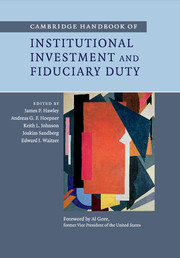Book contents
- Frontmatter
- Contents
- List of figures
- List of tables
- List of contributors
- Foreword
- 1 Introduction
- Part I Fiduciary duty: a global outlook
- Part II Fiduciary duty and the landscape of institutional investment
- 8 The philanthropic fiduciary: challenges for nonprofits, foundations and endowments
- 9 Paradigm lost: employment-based defined benefit plans and the current understanding of fiduciary duty
- 10 Economically targeted investing: changing of the guard
- 11 Institutional investment in the European Union Emissions Trading Scheme
- 12 Have institutional fiduciaries improved securities class actions? A review of the empirical literature on the PSLRA’s lead plaintiff provision
- 13 The future of fiduciary obligation for institutional investors
- Part III Challenging conventional wisdom on fiduciary duty
- Part IV Towards a broader interpretation of fiduciary duty
- Part V Beneficiaries’ roles and viewpoints
- Part VI Fiduciary duty and governance
- Index
- References
8 - The philanthropic fiduciary: challenges for nonprofits, foundations and endowments
Published online by Cambridge University Press: 05 April 2014
- Frontmatter
- Contents
- List of figures
- List of tables
- List of contributors
- Foreword
- 1 Introduction
- Part I Fiduciary duty: a global outlook
- Part II Fiduciary duty and the landscape of institutional investment
- 8 The philanthropic fiduciary: challenges for nonprofits, foundations and endowments
- 9 Paradigm lost: employment-based defined benefit plans and the current understanding of fiduciary duty
- 10 Economically targeted investing: changing of the guard
- 11 Institutional investment in the European Union Emissions Trading Scheme
- 12 Have institutional fiduciaries improved securities class actions? A review of the empirical literature on the PSLRA’s lead plaintiff provision
- 13 The future of fiduciary obligation for institutional investors
- Part III Challenging conventional wisdom on fiduciary duty
- Part IV Towards a broader interpretation of fiduciary duty
- Part V Beneficiaries’ roles and viewpoints
- Part VI Fiduciary duty and governance
- Index
- References
Summary
Introduction
Charitable purpose is the primary differentiating factor between nonprofits and their for-profit siblings. Tax-exempt nonprofits are granted special tax status in exchange for pursuing specified public benefits. The underlying rationale is that philanthropic activities will reduce the burdens on government or otherwise provide a social good (Phelan 2010: 12:8). This trade-off between generating a public benefit and receiving an associated tax advantage is the policy basis upon which the nonprofit sector exists.
In order to align the governance of nonprofits with this core policy goal, directors of philanthropic organizations and trustees of charitable trusts are subject to fiduciary standards that serve as guides for their conduct. Those legal obligations are similar to the fiduciary duties of for-profit company directors and trustees of investment trusts. However, nonprofit directors have an additional fiduciary duty, one of obedience to the organization’s charitable mission and purpose. That duty of obedience also engenders an oversight responsibility to prevent drift away from both its charitable mission and the public purpose that underlies the nonprofit’s tax exemption.
- Type
- Chapter
- Information
- Publisher: Cambridge University PressPrint publication year: 2014



